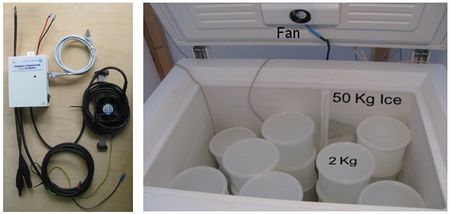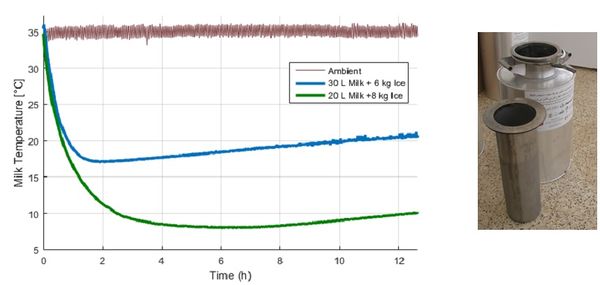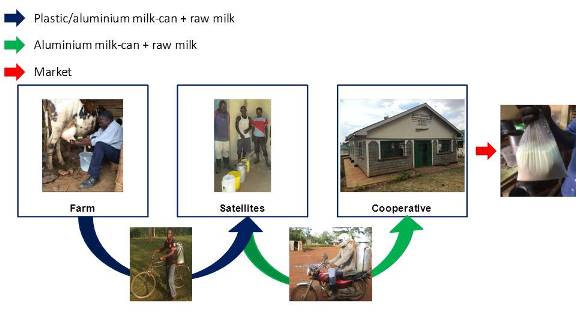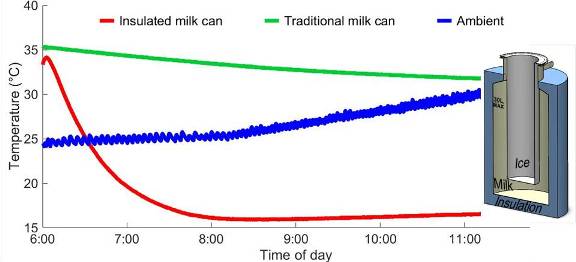Knowledge fuels change
For over a decade, Energypedia has shared free, reliable energy expertise with the world.
We’re now facing a serious funding gap.
Help keep this platform alive — your donation, big or small, truly matters!
Thank you for your support
Difference between revisions of "Solar Milk Cooling with Insulated Milk Cans"
***** (***** | *****) |
***** (***** | *****) m |
||
| Line 6: | Line 6: | ||
<br/> | <br/> | ||
| − | = Hohenheim | + | = Hohenheim System for On-farm Milk Cooling with Solar Energy<br/> = |
[[File:Solar Milk Cooling System Overview.jpg|border|right|350px|Solar Milk Cooling System for 60 liter per day ( PV-Panels, Batteries, Adaptive control unit, Ice-maker and 2 Isolated milk cans)|alt=Solar Milk Cooling System for 60 liter per day ( PV-Panels, Batteries, Adaptive control unit, Ice-maker and 2 Isolated milk cans)]] The milk cooling solution developed by the University of Hohenheim is based on a commercially available DC Refrigerator equipped with an adaptive control unit for its conversion to a smart ice-maker that operates depending on the availability of solar energy. The ice-maker has a volume of 160l and is capable of producing approx. 8-13 kg ice per day. One system includes 25 reusable plastic blocks of 2 kg capacity and two 30l insulated milk cans with removable ice compartment. To cool down 30l of milk from 36°C to 15°C in one of the supplied milk cans, the systems needs 6kg of ice and 90 minutes.<br/> | [[File:Solar Milk Cooling System Overview.jpg|border|right|350px|Solar Milk Cooling System for 60 liter per day ( PV-Panels, Batteries, Adaptive control unit, Ice-maker and 2 Isolated milk cans)|alt=Solar Milk Cooling System for 60 liter per day ( PV-Panels, Batteries, Adaptive control unit, Ice-maker and 2 Isolated milk cans)]] The milk cooling solution developed by the University of Hohenheim is based on a commercially available DC Refrigerator equipped with an adaptive control unit for its conversion to a smart ice-maker that operates depending on the availability of solar energy. The ice-maker has a volume of 160l and is capable of producing approx. 8-13 kg ice per day. One system includes 25 reusable plastic blocks of 2 kg capacity and two 30l insulated milk cans with removable ice compartment. To cool down 30l of milk from 36°C to 15°C in one of the supplied milk cans, the systems needs 6kg of ice and 90 minutes.<br/> | ||
| Line 86: | Line 86: | ||
[[File:Insulated milk can with ice compartment.jpg|center|600px|alt=Insulated milk can with ice compartment.jpg]]<br/> | [[File:Insulated milk can with ice compartment.jpg|center|600px|alt=Insulated milk can with ice compartment.jpg]]<br/> | ||
| − | |||
| − | |||
| − | |||
| − | |||
= Collaboration Partners<br/> = | = Collaboration Partners<br/> = | ||
| Line 118: | Line 114: | ||
*[http://research4agrinnovation.org/ PARI - Program of AccompanyingResearch for Agricultural Innovation] | *[http://research4agrinnovation.org/ PARI - Program of AccompanyingResearch for Agricultural Innovation] | ||
| − | |||
| − | |||
| − | |||
| − | |||
<br/> | <br/> | ||
| Line 174: | Line 166: | ||
Currently, the evaluation is being performed in collaboration with PA, GIC, Jaramogi Oginga Odinga University of Science and Technology (JOOUST), SAM Malanga dairy cooperative society. The first stage of this research is covering the installation and monitoring the system at the cooperative. Further research will focus in the evaluation of the system in early stages of milk handling (satellites and farm). | Currently, the evaluation is being performed in collaboration with PA, GIC, Jaramogi Oginga Odinga University of Science and Technology (JOOUST), SAM Malanga dairy cooperative society. The first stage of this research is covering the installation and monitoring the system at the cooperative. Further research will focus in the evaluation of the system in early stages of milk handling (satellites and farm). | ||
| − | |||
| − | |||
| − | |||
| − | |||
= Publications and Documents = | = Publications and Documents = | ||
| − | [[:File:Solar powered cooling for enhancing milk value chains - Rural 21.pdf|Article at Rural 21 - Solar powered cooling for enhancing milk value chains]] | + | * [[:File:Solar powered cooling for enhancing milk value chains - Rural 21.pdf|Article at Rural 21 - Solar powered cooling for enhancing milk value chains]] |
| − | + | * [[:File:User Guide - On-farm Solar Milk Cooling System.pdf|User Guide of the on-farm solar milk cooling system]]<br/> | |
| − | [[:File:User Guide - On-farm Solar Milk Cooling System.pdf|User Guide of the on-farm solar milk cooling system]]<br/> | ||
<br/> | <br/> | ||
| Line 197: | Line 184: | ||
*For further information, please contact the author of this article. [https://www.uni-hohenheim.de/institution/fg-agrartechnik-in-den-tropen-und-subtropen https://www.uni-hohenheim.de/institution/fg-agrartechnik-in-den-tropen-und-subtropen]<br/> | *For further information, please contact the author of this article. [https://www.uni-hohenheim.de/institution/fg-agrartechnik-in-den-tropen-und-subtropen https://www.uni-hohenheim.de/institution/fg-agrartechnik-in-den-tropen-und-subtropen]<br/> | ||
| + | [[Category:Powering_Agriculture]] | ||
| + | [[Category:Productive_Use]] | ||
[[Category:Photovoltaic_(PV)]] | [[Category:Photovoltaic_(PV)]] | ||
| − | |||
| − | |||
Revision as of 07:28, 28 June 2017
Introduction
In many countries, milk is exclusively produced by small and medium sized dairy farms with daily milk output below 200l. Their milk, in most of the cases is transported to milk collection facilities without any form of cooling. In addition, lack of hygiene and cleaning procedures and problems with cattle health are the most common reasons of high bacterial growth during short-term storage of milk on the farm and during transportation. Under warm climatic conditions, milk can exceed the maximum bacterial count prescribed by food safety laws after about two to five hours. During the hottest periods of the year, lack of quality can lead to high rates of refused milk at collection centers or dairy plants. Furthermore, due to low production volumes, evening milk is often not collected year round, thus causing additional on-farm losses. Small-scale solar powered milk cooling technologies can support the milk value chain at farm, cooperative and collecting center level by increasing productivity and giving access to price premiums and to additional markets.
Hohenheim System for On-farm Milk Cooling with Solar Energy
The milk cooling solution developed by the University of Hohenheim is based on a commercially available DC Refrigerator equipped with an adaptive control unit for its conversion to a smart ice-maker that operates depending on the availability of solar energy. The ice-maker has a volume of 160l and is capable of producing approx. 8-13 kg ice per day. One system includes 25 reusable plastic blocks of 2 kg capacity and two 30l insulated milk cans with removable ice compartment. To cool down 30l of milk from 36°C to 15°C in one of the supplied milk cans, the systems needs 6kg of ice and 90 minutes.
The smart ice-maker is powered by 600 Wp solar PV modules together with two batteries with a total capacity of around 1.5kWh. Thanks to the thermal energy storage, in form of the 25 2kg-Ice-blocks, the system is able to run autonomously for up to 5 days even during periods of low solar radiation and high ambient temperatures.[1]
Ice-Maker with Adaptive Control Unit[2]
The implemented adaptive control unit allows the efficient use of conventional DC-Refrigerators for a intensive and reliable production of ice all over the year. The ice-maker is equipped with following features:
- Variable compressor speed in dependence of solar radiation and state of charge of the batteries.
- Operation of a fan in the inner chamber in order to increase freezing rate.
- Energy saving mode during night and rainy days.
- Use of batteries to increase daily ice production up to 30%.
- Storage of 50 kg ice blocks to assure a autonomy of at least 5 days under low radiation or high ambient temperatures.
Insulated Milk Cans
The milk-cans implemented are made of stainless-steel and have a capacity of 30 liter milk and 8 kg Ice. This allows a flexible use of them depending on the cooling requirements. The milk-can has been design to operate for two modes as described in following table.
|
|
30 Liter milk + 6kg Ice |
20 Liter milk + 8kg Ice |
|
Cooling temperature |
17°C after 90 min. |
Under 10°C after 150 min. |
|
Used for |
Transport of morning milk |
Storage of evening milk |
|
Milk quality preservation |
At least 6 hours |
At least 12 hours |
The cooling performance and bacterial growth were measured with real milk under lab conditions in a climate chamber. On-field milk quality assessments are currently carried out in order to confirm the potential of the system to retard bacterial growth depending on milk temperature and transport time under real working conditions.[1]
Collaboration Partners
Research and Development:
Agricultural Engineering in the Tropics and Subtropics (University of Hohenheim)
Commercialization:
Field Assessments:
- International Center for Agricultural Research in the Dry Areas (ICARDA)
- Tunisian Ministry of Agriculture (INRAT, OEP, CRRA-IRESA, Groupment Interprofessionnel des Viandes Rouges et du Lait, National Veterinary School of Sidi Thabet)
- Delice
- Powering Agriculture and Green Innovation Center (Tunisia and Kenya)
Supported by:
German International Cooperation Agency (GIZ)
- Innovation Transfer into Agriculture - Adaptation to Climate Change (ITAACC)
- Sustainable Energy for Food - Powering Agriculture
German Ministry for Economic Cooperation and Development (BMZ)
On-Field Implementations
- Tunisia, July 2015 until December 2017:
In order to evaluate the potential of solar milk cooling systems under real conditions, an on-field project is currently carried out in Sidi Bouzid (Tunisia) under the coordination of the International Center for Agricultural Research in the Dry Areas (ICARDA) and the support of the GIZ through the ITAACC program, founded by the German Ministry for Economic Cooperation and Development (BMZ). At national level, the project is managed by the Tunisian Institute of Agriculture Research (INRAT) and several partners from the Agriculture Ministry and the dairy industry. The assessed solar milk cooling solution has been developed by the University of Hohenheim and is commercialized through the company and project partner PHAESUN GmbH. Additionally, the project counts on the support of the Powering Agriculture initiative of the GIZ for the social related assessments.
The region of Sidi Bouzid, in central Tunisia, is responsible for approximately one sixth of the national milk production in Tunisia. The majority of its milk is produced by small and medium sized dairy farms with ten to twenty cows and a daily milk output below 200l. Their milk is currently being produced on farm and transported to milk collection facilities without cooling. In this situation, bacterial growth during on farm short-term storage and transportation represents a significant problem for the dairy sector.
The project implementation with duration until December 2017, supports the assessment of a solar-powered milk cooling solution, designed to meet the refrigeration needs of small and medium-sized dairy farmers of the region. The ice-based cooling solution was developed specifically to overcome the challenges during short-term on-farm storage of milk and transportation to collection centers.
Since April 2016, 10 solar systems of the presented milk cooling solution are operating in 7 farms in the region of Sidi Bouzid . Each system has a capacity of 60l per day while 3 farms were equipped with two system due to higher production volumes up to 120 liter milk per day.
The performance of the solar ice-makers is currently monitored in order to confirm the right use of the system by the farmers and the daily availability of 12kg ice. Additionally experts interviews are carried out for farmers and dairy industry to assets the acceptance of the milk-cans by daily use together with the social impact in terms of gender and labor organization.
From the economical side, the potential of the system to increase productivity and preserve milk quality will be analyzed as main pillars to support the milk value chain and generate business opportunities. Furthermore the system cost will be reduced by the development of milk-cans able to be produced locally. [3]
- Kenya, January 2016 until December 2017:
Smallholder dairy farms are the major providers of marketed milk in Kenya becoming even stronger when associating in cooperatives. The channels of raw milk production from the farm to the market are shown in Figure 1. These groups are mostly constrained by lack of cooling systems, reduced hygiene minimum cleaning procedures and in some cases problems with cattle health, resulting in high microbial contamination. Under warm climatic conditions, raw milk can exceed the maximum bacterial count after two to five hours without cooling resulting in a lack of quality and leading to high rates of rejected milk at the different stages of collection. Therefore, drawing on the experience with an ongoing research project in Tunisia, the group is pilot testing a solar-based cooling system that can be operated independently offering an off grid solution for remote areas. This research aims the development of dairy value chains in an integrated approach to improve productivity and reduce losses along the value chain. The work is supported by the Program of Accompanying Research for Agricultural Innovation – PARI and GIZ initiatives in Kenya (Powering Agriculture-PA and Green Innovation Centres – GIC).
Figure 1. Handling of milk from the farm town ward to the satellites (collecting point) and then to the cooperative for further processing.
The success for the implementation of this innovative technology relies on the plastic insulated milk can. As a first stage of the introduction of the technology, measurements on milk temperature during transport were collected from milking to the moment of retailing at SAM Malanga dairy cooperative society in Siaya county (located at 0.06 N, 34.29 E). The target was the establishment of the state of the art in the region. Milk temperature profiles were genertated over the transport time to the cooperative as it is shown in Figure 2. By performing this procedure, a low milk quality could be expected.
Figure 2. Ambient temperature and milk temperature during transport from the farm to the cooperative.
Base on this initial information, milk temperature profile was evaluated in the insulated milk can and compare with a traditional milk can (aluminum milk can) following the protocol for the stainless steel insulated milk can for Tunisia. Figure 3 shows the similar performance of the stainless steel milk can, which will result in preservation of milk quality.
Figure 3. Cooling performance of the insulated milk can under laboratory conditions (climate chamber) for 30 Liter milk and 6 kg ice.
Currently, the evaluation is being performed in collaboration with PA, GIC, Jaramogi Oginga Odinga University of Science and Technology (JOOUST), SAM Malanga dairy cooperative society. The first stage of this research is covering the installation and monitoring the system at the cooperative. Further research will focus in the evaluation of the system in early stages of milk handling (satellites and farm).
Publications and Documents
- Article at Rural 21 - Solar powered cooling for enhancing milk value chains
- User Guide of the on-farm solar milk cooling system
Overview of Solar Milk Cooling Systems
References
- ↑ 1.0 1.1 2013-2016 Victor Torres Toledo, Ana Salvatierra Rojas, Alice Hack, Joachim Müller. University of Hohenheim. On going research at the Institute of Agriculture Engineering. Tropics and Subtropics Group.
- ↑ 2016 Victor Torres-Toledo, Klaus Meissner, Philip Täschner, Santiago Martınez-Ballester, Joachim MüllerfckLRDesign and performance of a small-scale solar ice-maker based on a DC-freezer and an adaptive control unit. fckLRSolar Energy Journal Publication.fckLRhttp://dx.doi.org/10.1016/j.solener.2016.10.022
- ↑ 2015-2017 On-field Project: Field Testing of an Innovative Solar Powered Milk Cooling Solution for the higher Efficiency of the Dairy Subsector in Tunisia
- For further information, please contact the author of this article. https://www.uni-hohenheim.de/institution/fg-agrartechnik-in-den-tropen-und-subtropen



























